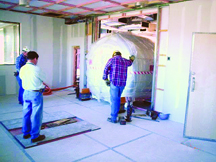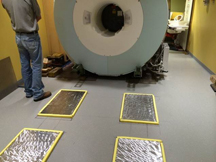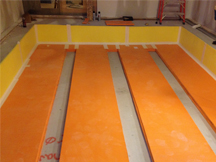Treatments to Protect Medical Offices from MRI Sound Disruption
With the continued evolution of technology, the healthcare industry has asked their MRI (Magnetic Resonance Instrument) suppliers for higher levels of performance. Each advancing generation of machine has increased in size and energy it emits. One result is more concern about the vibration that’s created and how it affects both the patient experience and the imagery results.
The MRI suite is certainly a focal point for this concern and warrants the attention necessary to make any new MRI project as sound- and vibration-free as possible. The time to address this is early in the process – not later or after the MRI installation. MRI manufacturers have addressed (to differing degrees) the vibration issue in their product design and through suggested installation methods. However, the industry is discovering that each site is specific and should be reviewed based on individual conditions such as floor location and building structure.
Proper isolation of an MRI system facilitates lower noise and vibration levels. Achieving proper isolation requires a good solution and the technical experience to design an isolation program that meets the expected requirements. Soundown supplies the know-how and experience to efficiently reach vibration and noise reduction goals. With over 20 years of experience working with MRI manufacturers and healthcare facilities, we understand that every project is unique. Our technical staff will work with you to understand your requirements and design an isolation package tailored to your project. This process takes into account performance requirements as well as site details, resulting in a solution that fits your mechanical, budgetary, and logistical constraints.
Often overlooked, when considering the efficiency of an isolation system is the supporting structure to which the MRI is fastened. Structure with insufficient impedance will allow vibrational energy to transmit into the structure. Working with the complete team (owner, architects, structural engineers, acoustical consultant, general contractor, subcontractors, shielding vendor, installation crew, etc.), we can provide coordinated guidance, including foundation requirements and all other aspects of a noise and vibration control package.
Proper isolation of equipment and systems is the foundation for a quiet, smooth-running MRI. Get Soundown involved as early as possible in the design phase of your next MRI project and ask us to design the solution for you.
Level 1: Foot Isolation
As a basic solution, most of the major MRI manufacturers provide an isolation system that they have defined to cover an expected majority of sites and conditions for their machines.
In many of the projects, the manufacturer includes this treatment and installation instruction with the delivery of the MRI machine. Other projects may only be supplied a blueprint of information defining what needs to be done to isolate each foot of the machine.
Comments:
- Least costly of the isolation options
- Easy to incorporate into a project
- May provide adequate isolation for many sites
Level 2: Overall Footprint Isolation
While the basic treatment seems to satisfy many sites, concern for a higher level of isolation is common. This is due in part to the increase in sensitivity demanded by patients and in part to increases in energy output that require improved isolation. 
Description:
More sites are requiring the entire footprint of the MRI be isolated. This often means offering a double isolation technique, defined by the specific MRI model and the conditions of the site. Most commonly, the solution incorporates a large inertia slab/plate.
Comments:
- A step up in improving the isolation for many MRI projects
- Requires a bit more engineering and design effort
- Allows for double isolation to address potential unknown frequencies on upper levels of buildings
Level 3: Overall Room Isolation
As an advanced solution for MRI Isolation, many locations are calling for the entire room to be isolated. With the increased importance for healthcare facilities to meet or exceed industry expectations, there is more focus on being cautious about isolation requirements.
This approach incorporates isolation of the entire MRI room floor (including beneath the perimeter walls and the MRI machine). The gauge and grade of isolation are defined after thorough reviews of the project details.
Comments:
- Provides the greatest level of isolation efficiency
- Requires extensive coordination with the architects, shielding vendor, and contractors
- Gives the owner the level of confidence expected for a leading facility


